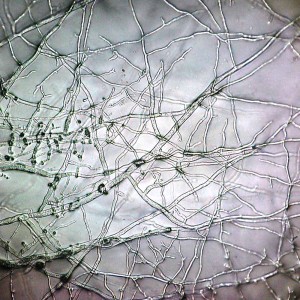Did you know that beneath your feet is an information superhighway built of networked fungi that allow plants to communicate?
 Recent studies have revealed some amazing information about how plants communicate. They use a sort of networked fungus called “mycorrhizae”. The term mycorrhizae means “fungus root”. These thin strings of fungus attach to the roots of nearby plants and form a symbiotic relationship between plants of various species. Whether it be the roots of Morninga, Guanacaste Trees, or Winged Beans, they all serve can each other. The BBC published an article which states that about “90% of land plants are in mutually beneficial relationships with fungi”. It refers to this plant to plant communication as a sort of “hidden internet”.
Recent studies have revealed some amazing information about how plants communicate. They use a sort of networked fungus called “mycorrhizae”. The term mycorrhizae means “fungus root”. These thin strings of fungus attach to the roots of nearby plants and form a symbiotic relationship between plants of various species. Whether it be the roots of Morninga, Guanacaste Trees, or Winged Beans, they all serve can each other. The BBC published an article which states that about “90% of land plants are in mutually beneficial relationships with fungi”. It refers to this plant to plant communication as a sort of “hidden internet”.
One study even shows that simply plugging in to mycelial networks can make plants more disease resistant. The crazy thing is, some studies are showing that through the use of these fungal networks, plants can share altruistically. There’s evidence that not only do plants change their behavior in the presence of siblings, but they may benefit from the presence of siblings. It makes you think about your garden in a whole new light.
Nerds Rejoice…..Grow Your Ponytails, Avatar is True!
This whole ‘talking plant network’ concept may sound familiar if you’ve seen the movie Avatar. In the movie, the trees and plants are all connected through a network of “electrochemical communication between the roots”. This may not be that far from the truth.
![]()
The latest data is revealing “complex ways that plants exchange information with one another. Researchers are unearthing evidence that, far from being unresponsive and uncommunicative organisms, plants engage in regular conversation. In addition to warning neighbors of herbivore attacks, they alert each other to threatening pathogens and impending droughts, and even recognize kin, continually adapting to the information they receive from plants growing around them. While agriculturists and environmentalists often have to make use of tech to ascertain upcoming weather conditions, plants have the inherent (as yet unknown) power of knowing, and even communicating the myriad changes in nature. Moreover, plants can “talk” in several different ways: via airborne chemicals, soluble compounds exchanged by roots and networks of thread like fungi, and perhaps even ultrasonic sounds. Plants, it seems, have a social life that scientists are just beginning to understand.”
Fungi were among the first organisms on earth 1 billion years ago and they ought not be underestimated.
Mushroom Dude – Paul Stamets
Over the last 40 years, Mycologist Paul Stamets has discovered several new species of mushrooms, and revolutionized mushroom cultivation. Stamets runs Fungi Perfecti, a family-owned gourmet and medicinal mushroom business in Shelton, Wash. He’s collected and cloned more than 250 strains of wild fungi and is convinced that they will have a significant role in the future of agriculture, medicine and ecology. His statements are may seem grandiose, but some say his patents on fungus tech are the bane of modern pesticide companies. Last June, he received a patent on using “entomopathogenic Fungi”(fungi that kills insects). We’ll see!
If you’re interested in tapping into some of the known health benefits of medicinal mushrooms see our other post: Top 5 Medicial Mushrooms You Need To Know
In the talk above, Paul shares six ways that mycelium fungus – could save the world.
- They can clean polluted soil. In this talk, Stamets describes an experiment where he put storm-blown mycelium in burlap sacks, and placed them downstream from a factory producing E-Coli. In 48 hours, the mushrooms reduced the amount of coliform bacteria in the soil 10,000 times. He shows how similar mushroom technology could also clean oil, and restore habitats near polluting factories.
- They are a possible Smallpox treatment. Stamets and his team have identified three different strains of Agarikon mushrooms which are highly active against poxviruses.
- They are effective against flu viruses. Based on the results of Agarikon mushrooms against pox, Stamet’s team tested if they would be active against flu A viruses and flu B viruses. They were found to work very well.
- They are possible replacement for current insecticide usage. Stamets shows how a non-sporulating form of mushroom can attract bugs like carpenter ants, and then kill them. The magic mushroom is called “entomopathogenic Fungi” (fungi that destroys or disables insects). It works by attracting the insects. They eat the fungus, which in-turn consumes the insect from the inside out! The other plus is that after it spores, it repel bugs making an area unsuitable for infestation. Extracts can even guide and corral bug movements.
- They can turn cardboard boxes into old growth forests. Toward the end of his talk, Stamets introduces us to the “Life Box,” cardboard which is made with mycorrhizal and endophytic fungi as well as spores. Add soil, tree seeds and water and you can grow a forest that has many of the qualities only seen in old growth forest ecosystems.
- They can generate ethanol from cellulose using mycelium as an intermediary. Mycelium can convert cellulose into sugars which could them be converted to an ethanol. Maybe one day, we’ll be driving cars running on mushroom gas.
Sources:
Why We Need Mushrooms, Paul Stamets in Mother Earth News
Salon.com | Technology: How Mushrooms will Save the World
Assembly of Complex Plant Networks – Nature.com
Smallpox Defense May Be Found in Mushrooms – NPR Interview
Altruistic Behavior in Plants – PRI.org



GIPHY App Key not set. Please check settings